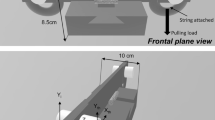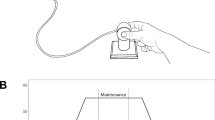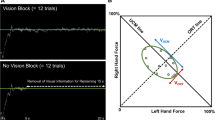Abstract
Older women were less accurate and required more time in tracing a triangle template by controlling the force on spring levers with three different finger combinations: a one-hand precision pinching movement, a bilateral index finger movement, and a left index finger and right thumb combination. Older subjects were disproportionately less accurate than young subjects when required to decouple the pinching movement and control the index finger and thumb independently. Effects of practice were similar for both age groups, except that the elderly increased behavioral speed more from the first to the second day of practice. Explanations for the findings were based on neurosynergistic-intentional control interactions, visuospatial deficits in the elderly, and older subjects’ predisposition to perseverate.
Access this chapter
Tax calculation will be finalised at checkout
Purchases are for personal use only
Preview
Unable to display preview. Download preview PDF.
Similar content being viewed by others
References
Abbs, J. H., Gracco, V. L. (1984). Control of complex motor gestures: Orofacial muscle responses to load perturbations of the lip during speech. Journal of Neurophysiology, 51, 705–723.
Barrack, R. L., Skinner, H. B., Cook, S. D., & Haddad, Jr., R. J., (1983). Effect of articular disease and total knee arthroplasty on knee joint-position sense. Journal of Neurophysiology, 50, 684–687.
Brinkman, J., & Kuypers, H. G. J. M. (1973). Cerebral control of contralateral and ipsilateral arm, hand and finger movements in the split-brain Rhesus monkey. Brain. 96, 653–674.
Caccia, M. R., McComas, A. J., Upton, A. R. M., & Blogg, T. (1973). Cutaneous reflexes in small muscles of the hand. Journal of Neurology, Neurosurgery, and Psychiatry, 36, 960–977.
Cole, K. J. (1991). Grasp force control in older adults. Journal of Motor Behavior. 22, 251–258.
Cole, K. J. & Abbs, J. H. (1986). Coordination of three-joint digit movements for rapid finger-thumb grasp. Journal of Neurophysiology, 55, 1407–1423.
Cullum, C. M., Thompson, L. L., & Heaton, R. K. (1989). The use of the Halstead-Reitan Test Battery with older adults. In Clinics in Geriatric Medicine, 5, 595–610. Philadephia, PA: W. B. Saunders Co.
Darton, K., Lippold, O. C. J., Shahani, M., & Shahani, U. (1985). Long-latency spinal reflexes in humans. Journal of Neurophysiology, 53, 1604–1618.
Doetsch, G. S. & Gardner, E. B. (1972). Relationship between afferent input and motor output in sensorimotor cortex of the monkey. Experimental Neurology. 35. 78–97.
Evarts, E. V., Fromm, C., Kröller, J., & Jennings, V. A. (1983). Motor cortex control of finely graded forces. Journal of Neurophysiology, 49, 1199–1215.
Falduto, L. L., & Baron, A. (1986). Age-related effects of practice and task complexity on card sorting. Journal of Gerontology, 41, 659–661.
Gandevia, S. C. & McClosky, D. I. (1977). Effects of related sensory inputs on motor performances in man studied through changes in perceived heaviness. Journal of Physiology, 272, 653–672.
Garnett, R. & Stephens, J. A. (1980). The reflex responses of single motor units in human first dorsal interosseus muscle following cutaneous afferent stimulation. Journal of Physiology (London), 303, 351–364.
Haggard, P. (1991). Task coordination in human prehension. Journal of Motor Behavior, 23, 25–37.
Hikosaka, O., Tanaka, M., Sakamoto, M., & Iwamura, Y. (1985). Deficits in manipulative behaviors induced by local injections of muscimol in the first somatosensory cortex of the conscious monkey. Brain Research, 325, 375–380.
Hughes, S. L., Edelman, P., Chang, R. W., et al. (1991). The GERI-AIMS scales for the elderly: Reliability and validity. Arthritis and Rheumatisim,.
Jebsen, R. H., Taylor, N., Trieschmann, R. B., et al. (1969). An objective and standardized test of hand function. Archives of Physical Medicine and Rehabilitation. 49, 311.
Jette, A. M., Branch, L. G., & Berlin, J. (1990). Musculoskeletal impairments and physical disablement among the aged. Journal of Gerontology: Medical Sciences, 45, M203–208.
Johansson, R. S. & Westling, G. (1983). Influences of cutaneous sensory input on the motor coordination during precision manipulation. In C. von Euler, O. Franzén, U. Lindblom, & D. Ottoson (Eds.). Somatosensory mechanisms. New York: Plenum Press.
Johansson, R. S. & Westling, G. (1987). Signals in tactile afferents from the fingers eliciting adaptive motor responses during precision grip. Experimental Brain Research. 66, 141–154.
Kenshalo, Sr., D. R. (1986). Somesthetic sensitivity in young and elderly humans. Journal of Gerontology, 41, 732–742.
Kokmen, E., Bossemeyer Jr., R. W., & Williams, W. J. (1978). Quantitative evaluation of joint motion sensation in an aging population. Journal of Gerontology. 22, 62–67.
Lee, W. A. (1984). Neuromotor synergies as a basis for coordinated intentional action. Journal of Motor Behavior. 16. 135–170.
Light, K. & Spirduso, W. (1990). Effects of adult aging on the movement complexity factor of response programming. Journal of Gerontology, 45, P107–P109.
Marsden, C. D., Merton, P. A. & Morton, H. B. (1973). Is the human stretch reflex cortical rather than spinal? Lancet i, 759–761.
Muramoto, O. (1984). Selective reminding in normal and demented aged people: Auditory verbal versus visual spatial task. Cortex, 20, 461–478.
Ogden, J. A. (1990). Spatial abilities and deficits in aging and age-related disorders. In Boiler, F., & Grafman, J. (Eds.). Handbook of Neuropscyhology, 4, 265–278.
Pacaud, S. & Welford, A. T. (1989). Performance in relation to age and educational level: A monumental research. Experimental Aging Research, 15, 123–136.
Passingham, R., Perry, H., & Wilkinsson, F. (1978). Failure to develop a precision grip in monkeys with unilateral neocortical lesions made in infancy. Brain Research, 145, 410–415.
Phillips, C. G., & Porter, R. (1964). The pyramidal projection to motoneurones of some muscle groups of the baboon’s forelimb. In J. C. Eccles & J. P. Schadé (Eds.). Physiology of spinal neurons . Progress in Brain Research, 12, 222–245. Elsevier, Amsterdam.
Potvin, A. R., Syndulko, K., Tourtellotte, W. W., Lemmon, J. A., & Potvin, J. H. (1980). Human neurologic function and the aging process. Journal of the American Geriatrics Society, 28, 1–9.
Riege, W. H., Metter, E. J., & Williams, M. V. (1980). Age and hemispheric asymmetry in nonverbal tactual memory. Neuropsychologia, 18, 707–710.
Rood, O. N. (1860). On contraction of the muscles induced by contact with bodies in vibration. American Journal of Science & Arts, 24, 449.
Salthouse, T. A. (1992). What do adult age differences in the Digit Symbol Substitution test reflect? Journal of Gerontology: Psychological Sciences, 47, P121–128.
Salthouse, T. A., Mitchell, D. R. D., & Palmon, R. (1989). Memory and age differences in spatial manipulation ability. Psychology and Aging, 4, 480–486.
Spirduso, W. W. (in press, projected Fall, 1993) Physical dimensions of aging. Champaign-Urbana, IL: Human Kinetics Press.
Stelmach, G. E., Goggin, N. L., & Amrhein, P. C. (1988). Aging and the restructuring of precued movements. Psychology and Aging, 3, 151–157.
Stern, J. A., Oster, P. J., & Newport, K. (1980). Reaction time measures, hemispheric specialization, and age.. In L. W. Poon (Ed.) Aging in the 1980s: Psychological issues, (pp. 309–326). American Psychological Association, Washington, D.C., 1980.
Thomas, D. H., Long, C., & Landsmeer, J. M. F. (1968). Biomechanical considerations of lumbricals behavior in the human finger. Journal of Biomechanics, 1, 107–115.
Veroff, A. (1980). The neuropsychology of aging. Psychological Research. 41, 259–268.
Wechsler, D. (1981). Manual for the Wechsler Adult Intelligence Scale-Revised. New York: Psychological Corporation.
Welford, A. T. (1958). Motor performance. In J. E. Birren & K. W. Schaie, Handbook of the psychology of aging. New York, NY: Van Nostrand.
Welford, A. T. (1985b). Practice effects in relation to age: A review and a theory. Developmental Neuropsychology, 1, 173–190.
Williams, M. E., Hadler, N., Earp, J. A. L. (1982). Manual ability as a marker of dependency in geriatric women. Journal of Chronic Disabilities, 35, 115.
Wright, B. M., & Payne, R. B. (1985). Effects of aging on sex differences in psychomotor reminiscence and tracking proficiency. Journal of Gerontology, 40, 179–184.
Author information
Authors and Affiliations
Editor information
Editors and Affiliations
Rights and permissions
Copyright information
© 1993 Springer Science+Business Media Dordrecht
About this chapter
Cite this chapter
Spirduso, W.W., Choi, J. (1993). Age and Practice Effects on Force Control of the Thumb and Index Fingers in Precision Pinching and Bilateral Coordination. In: Stelmach, G.E., Hömberg, V. (eds) Sensorimotor Impairment in the Elderly. NATO ASI Series, vol 75. Springer, Dordrecht. https://doi.org/10.1007/978-94-011-1976-4_24
Download citation
DOI: https://doi.org/10.1007/978-94-011-1976-4_24
Publisher Name: Springer, Dordrecht
Print ISBN: 978-94-010-4872-9
Online ISBN: 978-94-011-1976-4
eBook Packages: Springer Book Archive




